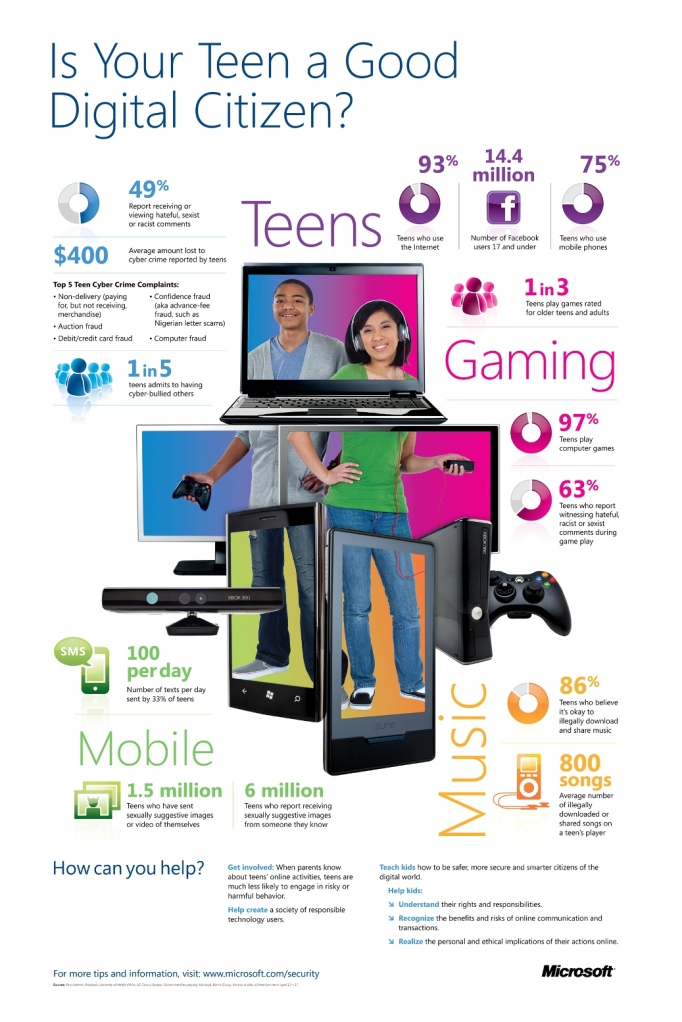
Infographic courtesy of http://www.microsoft.com/security
Digital Citizenship must become a priority in public education. However, technology misuse/abuse is a societal problem as much as it is a school problem. If we are to become a civilized technological society in the 21st century, technology leaders must create a vision for intelligent technology behavior. Digital Citizenship must become the norm and not the exception in our society. (Bailey & Ribble, 2005)
At this point, I hope all educators would agree that technology is part of education. I understand that this statement is only a hope. Once this hope becomes a reality, there are a plethora of educated people that understand that visionary leadership is the fundamental key that will change the expectations of the inclusion of technology in our classrooms. Bailey and Ribble’s quote above from a 2005 article is one of countless examples which underscore the need for leadership support.
Once leadership begins to think of technology as a given, which is actually required by our state standards, then we can move on to an implementation plan. In this day and age, with the commonality of technology, and with the inclusion of technology spelled out in the Common Core and the new Alaska state standards, I find it neglectful on behalf our our students that leadership has not grasped the need for educational technology for every one of our students. What will convince them? What entity needs to take them by the scruff of their necks to force this issue? A class action lawsuit was filed in the state of California to require all schools to provide equal access to instructional materials. I wonder if it will take a class action lawsuit to bring educational technology to every Alaskan classroom.
CommonSense Media outlined the educational need in their 2009 white paper.
The Need for Digital Literacy and Citizenship. This dynamic new world requires new comprehension and communication skills, as well as new codes of conduct, to ensure that these powerful media and technologies are used responsibly and ethically. Much of the interaction in this digital world happens at a distance, which can diminish the rules of cause and effect, action and consequence. Additionally, much of digital life takes place under the cloak of anonymity, making it easier to participate in unethical and even illegal behaviors. (CommonSense Media, 2009)
At the point that all accept the need for digital literacy and citizenship for each of our students, educators will need quality materials to help them consistently and accurately educate students. CommonSense Media is already a provider of such materials. Their materials are available for teachers via website links, downloadable iBooks, or mailed flash drives which are preloaded with all their material for teachers who do not have online access. Our Google discussion on the topic of CommonSense Media’s materials indicated a consensus that the materials where easy to use for both students and teachers who were at any level of comfort with technology.
The
iBooks are intended for devices that can easily play iBooks, like iPads. The books are available for four different age groups that range from Kindergarten to 12th grade. I downloaded one book as a sample on my MacBook and found that most of the
iBook functioned well, after the initial download. I was able to push the download to all my student computers in an overnight batch, in order to take advantage of the hours of the day when the broadband is least impacted. If students were allowed to bring their own devices at my school, the
iBooks would function better on iDevices. All the functionality, as the
iBooks intended, would be available on iDevices.
The online materials from CommonSense come in two forms. The
Digital Passport, which is intended for grades 3 – 5, provides an excellent platform for students to think about digital citizenship scenarios and skills. During instruction, using the online passport, teachers should take the opportunity to have open discussions with students about the scenarios and how those scenarios may apply in our students’ real lives. The
other materials that are available online for teachers are step-by-step lesson plans, videos, and toolkits. All are well-organized and relevant. For those teachers with highly unreliable Internet or no access to the Internet, CommonSense media offers their media
through the mail for a nominal fee.
My overall assessment of CommonSense materials is that they are excellent, relevant, and easy to use. Unfortunately, technology is still a choice for most educators, so only those that opt in will benefit from these terrific and free resources. I will continue to use these resources with my students few students in order to make some impact. Hopefully, others will follow suit.
———————–
Works Cited:
Bailey, G., & Ribble, M. (2005). Teaching digital citizenship: When will it become a priority for 21st century schools?. Retrieved from http://www.digitalcitizenship.net/uploads/TeachingDC10.pdf
Digital citizenship white paper. (2011). Retrieved from Microsoft website: http://go.microsoft.com/?linkid=9781980
Educating, empowering, and protecting america’s kids: A common sense media white paper. (2009). Retrieved from CommonSense Media website: http://www.itu.int/council/groups/wg-cop/second-meeting-june-2010/CommonSenseDigitalLiteracy-CitizenshipWhitePaper.pdf
Media and technology resources for educators. (2014). Retrieved from http://www.commonsensemedia.org/educators
San Francisco County Superior Court, (2009). Williams case: An explanation. Retrieved from California Department of Education website: http://www.cde.ca.gov/eo/ce/wc/wmslawsuit.asp
What does digital citizenship mean to you? (2014). Retrieved from http://www.microsoft.com/security/resources/digital-citizenship.aspx
